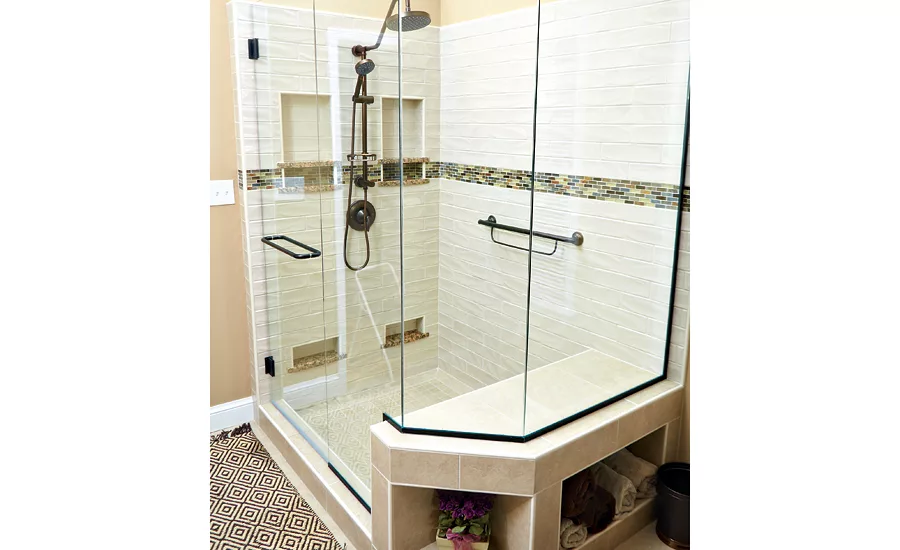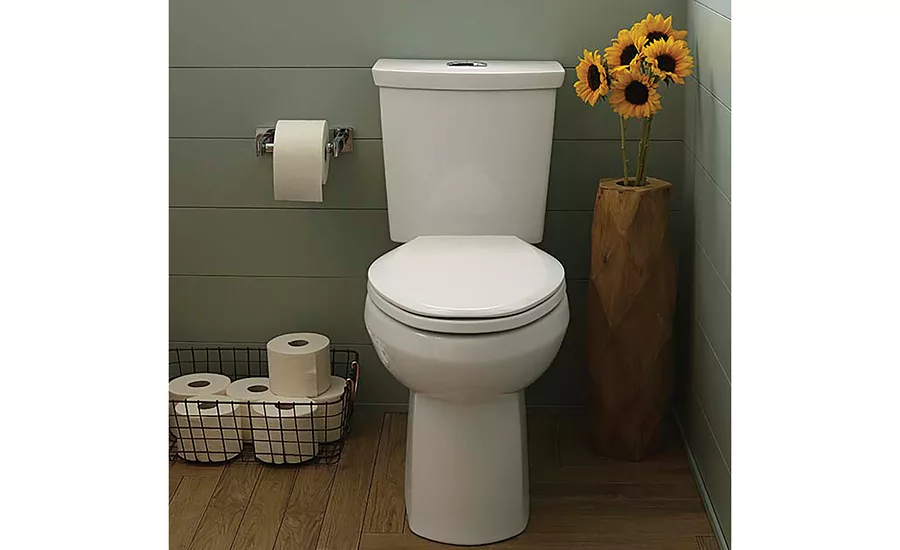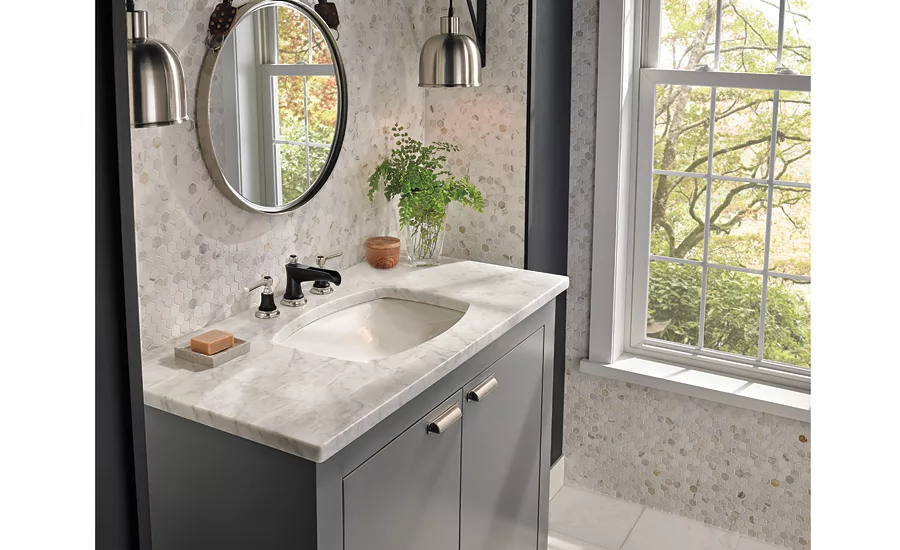Remodeling for small bath spaces
And staying on top of trends — decorative as well as technical — can give a plumbing contractor an edge over the competition.

Neutral colors are in as they help lighten up a small bathroom, and glass shower enclosures open the space up. Incorporating shower seats and grab bars during a remodel helps customers plan for the future.Photo credit: Criner Remodeling

Universal design and aging-in-place are defining a lot of remodeling decisions. This right-height toilet from American Standard includes H2Option dual-flush technology and a slow-close, easy-lift toilet seat.Photo credit: American Standard

Powder rooms are spaces where homeowners can introduce the “Wow!” factor. This Delta Faucet Co. black-and-gold faucet collection portrays opulence. Photo credit: Delta Faucet Co.

Single-handle faucets are ideal for small bath spaces as they make the sink lesscrowded and easier to clean, says Ebony Stephenson, a design and selectionsprofessional at Criner Remodeling in Newport News, Va. Photo credit: Moen
When people remodel their homes, they may be thinking resale value, but they’re also making themselves and their families happier. Upgrading appliances or updating fixtures can give homeowners an increased enjoyment in their homes, as well as a sense of accomplishment.
These are some of the findings found in the 2015 Remodeling Impact Report from the National Association of Realtors and the National Associaton of Remodelers. It notes that once remodeling projects are completed, 64% of homeowner respondents found “increased enjoyment” in their homes, 75% had a sense of accomplishment and more than 50% were happy about the changes made.
“Realtors know that remodeling projects aren’t just done to get more money for a home once it’s time to sell — a home is your sanctuary, the place you raise your family and where you make lifelong memories,” says NAR President Tom Salomone.
Judy Mozen, president of the National Association of the Remodeling Industry, agrees: “Remodeling projects can greatly improve both the value of and satisfaction with one’s home, which are great things no matter the reason for a project.”
Spending on home remodeling is trending up, says the National Association of Home Builders Remodelers — expect to see spending on renovations increase 1.1% this year and almost 2% in 2017. Remodeling contractors cite customers’ increased financial security for this growth.
Design professionals also are seeing growth in bathroom remodels. “We’re getting more leads for bathrooms than any other room in the house — more than kitchens, more than additions, more than anything,” says Ebony Stephenson, a design and selections professional at Criner Remodeling in Newport News, Va. “I think people are putting more emphasis on bathroom than kitchen remodeling.”
She adds that because of the electronics involved in many of today’s bath products — such as in toilet seats and digital shower controls — she believes more people are calling professionals to install these products instead of adding them to the DIY list. This is especially true for younger as well as older generations.
“Being 31 myself, and this will be my fifth year owning a home, I would save up as much money as I could to have a professional do the work,” Stephenson notes. “I say that because I have a very busy work schedule, and I don’t even have any children. Would I ever try to touch my kitchen or bathroom and do the work? No. Not at all. I would always hire a licensed professional to come in and do that.”
With the older generations, even retiring baby boomers, it comes down to how they want to spend their free time. Do they want to use it to remodel their bathroom, or do they want to hire someone so they can spend more time with the grandkids or travel without worrying about meeting the plumbing inspector?
Yes, there are DIYers in every generation, but at some point it makes more sense to hire a professional contractor. And staying on top of trends — decorative as well as technical — can give a plumbing contractor an edge over the competition.
A fresh canvas
It’s no surprise that bathroom renovations appeal to potential buyers as well as factor into higher resale value. But those changes also can make homeowners appreciate their homes more, especially if the bathroom is small. People with older homes or who live in vintage condo buildings aren’t blessed with spacious master bathrooms. Space is a commodity. They have to make do with creating stress-free environments in smaller spaces. A renovation gives the bathroom a fresh canvas your customers can use to imprint their vision.
“In a small bathroom, even minor changes can have a significant impact,” explains Jean-Jacques L’Henaff, vice president of design at LIXIL Water Technology Americas, American Standard and DXV. “Simply by installing a new sink faucet, homeowners can freshen up the look of the whole room. Faucets function like jewelry for the lavatory, and are a great way to make a dramatic new design statement.”
The National Kitchen and Bath Association identified 10 top bathroom renovation trends for 2016, some of which are perfect for small bath spaces. Understanding trends and how they relate to what your customers want allows you to suggest products that will meet their needs — whether it’s for a small master bath or a powder room. Report highlights include:
- More open shelving, floating vanities and built-in storage.Small bathrooms have little storage space. “For smaller bathrooms in condos, we design custom vanities to fit the space,” Stephenson says. “Some people prefer a furniture look, with feet on it or something to dress it up just a little bit. Others like something more simple.”
The custom cabinetry maker she works with builds reverse sink base cabinets. Instead of the false drawer on the top — where the plumbing is — it’s a full drawer on the bottom of the cabinet, with the doors on top.
- Transitional styles are more popular than contemporary.Stephenson adds that a single-hole faucet model makes the sink area less crowded and easier to clean.
- Quiet or soft-closing toilet seats.The obvious reason is no noise, but for Stephenson and some of her clients, it’s a hygiene issue. And today you can install bidet toilet seats, seats with night lights or an automatic air freshener, without using extra space.
- Aging-in-place amenities.This includes no threshold showers, grab bars, chair-height toilets, built-in seats and benches, and hand showers. You can read about ADA-compliant shower systems on page 44.
“The aging-in-place movement has influenced everything,” Stephenson explains. “Whether a client is old, young or in the middle, I always provide aging-in-place features in their bathrooms. Sometimes it can be an awkward conversation. If you’re doing a bathroom for a 50 year old, you don’t want to mention a grab bar, because he gets offended.”
When doing a remodel, it’s better to plan for the future, she adds. While it’s easier to plan for getting older, no one knows if they will get into a debilitating accident or be diagnosed with a degenerative disease.
- Neutral colors, such as white fixtures, and white/gray color schemes.In addition, Stephenson recommends using large tiles, which have fewer grout joints. “Visually, the room feels larger because you have fewer lines that are separating the room and breaking it up,” she explains. She also recommends adding more light, whether natural or low-heat LED lights. Smaller spaces heat up quicker, making them uncomfortable.
Accessories also are a key factor in small bathroom designs. “Having towel rings or various towel bar lengths (18- and 24-inches) and double towel bar options provide the functionality homeowners want while enhancing the design of the space,” says Mike Reffner, Moen’s senior manager, bath category, wholesale business unit. “Adding a hotel shelf, which combines a towel bar with a shelf, offers an excellent storage spot for towels.”
The half-bath
But powder rooms are a different story. Primarily used by guests, homeowners use these half-baths to introduce the “Wow!” factor into their homes.
“We see homeowners making a statement in the powder room in terms of faucets, accessories and overall style,” Reffner notes. “This may include a unique faucet platform such as a vessel or wall-mount faucet, paired with an eye-catching vessel sink bowl.”
Delta Faucet Co.’s Judd Lord, senior director of industrial design, agrees: “White and black bathrooms with warm, gold-toned or polished chrome fixtures are on the rise, creating a luxurious look we’re calling ‘jeweled luxury.’ Taking elements from both modern and traditional design, this look incorporates clean, geometric shapes with faceted surfaces and marble flooring. Jewel-inspired details and finishes in buffed gold with subtle iridescences offer long-lasting opulence.”
Stephenson notes that plumbing showrooms are extremely useful for clients because not only can they see the different styles of faucets and fixtures, including different finishes, they can test out working models of showers and toilets. This is especially important when discussing water-conserving products such as high-efficiency toilets or universal design products such as hand showers.
“Having working displays is very helpful because customers may think they want the best showerhead on the market, but if they can’t change the functions easily without hurting their joints, there’s no point in installing it and making their life more difficult,” she adds.
Plumbing manufacturers recognize that many people living in condos, apartments and small houses have space constraints in bath spaces, so products continue to enter the market to provide solutions for them.
“The greater availability of products specifically designed to maximize small bathrooms offers homeowners an incentive to remodel these often charming spaces,” L’Henaff says.
With remodeling spending on an upward trend, it’s time to get your piece of this market. Educating yourself and your employees on new bathroom products and technologies that provide solutions for space-challenged bathrooms and meet client needs is critical for success.
Looking for a reprint of this article?
From high-res PDFs to custom plaques, order your copy today!





